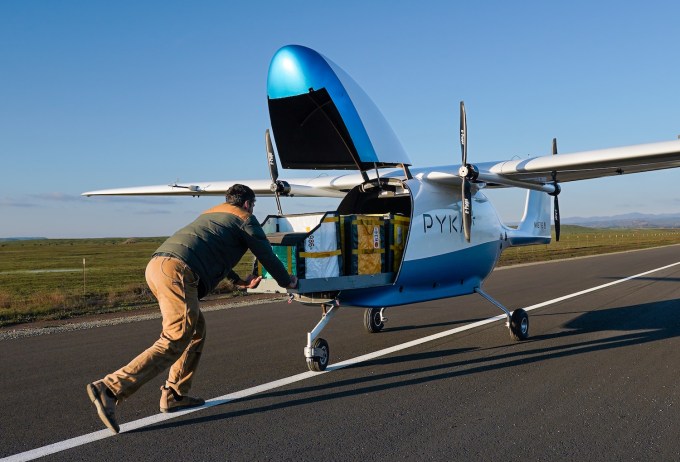Autonomous electric aviation startup Pyka is working hard to scale up its crop-dusting and cargo plane lines, but it has attracted a lucrative new suitor: the Pentagon. The promise of a climate-friendly dual-use self-flying plane was also too great for investors to resist, resulting in a new $40 million B round.
Pyka started in 2019 with a focus on crop-dusting, a business you might not personally encounter much but one that is both important and extremely outdated. The company’s lightweight, compact electric Pelican aircraft were designed to autonomously spray crops over large areas, relieving the dangerous and tedious work of human pilots or remote control operators.
Though it briefly worked on a passenger plane, the company decided after raising some money in 2022 that a cargo variant of the Pelican was more practical in the short term.
“We went from render to first flight in about 10 months, which was exciting. It’s very fast,” said co-founder and CEO Michael Norcia. At the time, their main goal was inter-island commerce, a market normally served by slow boats and old planes, keeping costs high and lead times long. Small, autonomous aircraft making quick puddle jumps daily with 400 pounds of cargo could transform many an island community.

But the cargo variant attracted the attention of a customer Norcia hadn’t yet considered a real possibility: the Defense Department.
“When we initially created the product, our focus was purely commercial use cases. We pretty quickly realized there was a lot of interest and need for the product in the defense world,” Norcia said. “It kind of caught us by surprise.”
“We always wondered if a vehicle in our class would have a place in defense logistics,” he explained. “Is it big enough? Is it OK that it can’t hover? But I think really because of the war in Ukraine, everyone’s mindset around autonomous systems in defense, and around logistics, and really just around problem solving has changed. When we started, it wasn’t clear, but now it’s like, 100%, of course logistics is going to be automated!”
The shift in military and general government procurement has been leaning toward more inexpensive, flexible, solutions that exist today rather than “exquisite” systems built to spec, with eight-figure price tags, that might exist in five years. And it isn’t hard for anyone to imagine the utility of a cargo-carrying drone fleet.
Not being a military contractor itself, Pyka has been working with aerospace veteran Sierra Nevada to make the kinds of changes needed for such a craft to be useful on a battlefield or contested environment. These are largely electronic, he said — they’re not adding guns and armor plating. The mil-spec one is called Rumrunner.
Norcia admitted that the decision to do defense work was not an easy one to make.
“Those conversations came up early and with pretty broad scope. It isn’t aligned with what everyone at the company wants to spend their days on, and it’s a topic I’ve tried to think deeply about,” he said. “The good news is automating logistics has some pretty positive externalities. I’m a proponent of moving things in a robot that is maybe going to get shot down by another robot. Whereas the status quo is a vehicle with people on it, getting shot down by other people.”
He pointed out that the government and military have a long history of subsidizing R&D in aviation, which is quite true — in fact, most people are surprised to hear that a huge amount of basic research across many domains is funded through Defense Department grants.
“There’s an existential element to it: aviation is a seriously non-trivial industry to be a part of. High regulatory hurdles, extremely high risk — I mean, neither of these are great news for an early stage startup trying to make money,” Norcia said. In other words, they weren’t necessarily in a position to say no. “The majority of aircraft delivered and income is related to defense partners at this point, and I expect that’s probably going to remain the case for the coming years. On the five- to 10-year horizon, I think the commercial use case is going to look increasingly strong, but it’s still regulatorily constrained.”

That doesn’t mean they aren’t working on it — their commercial endeavors are ongoing, and the new funding will help them scale up manufacturing after spending years tweaking and improving the design in response to customer feedback.
And despite putting the passenger plane on ice, Norcia said all their work still contributes toward that market eventually.
“We’re making progress!” he said. “That’s still the north star for us, we want to have success in the industrial use cases, then use that data advantage and cash flow to make a passenger carrying vehicle. That’s still the legacy we’d like Pyka to have.”
The $40 million B round was led by Obvious Ventures, with participation from Piva Capital, Prelude Ventures, Metaplanet Holdings, and Y Combinator.










![Best Weight Loss Supplements [2022-23] New Reports!](https://technologytangle.com/wp-content/uploads/2022/12/p1-1170962-1670840878.png)




